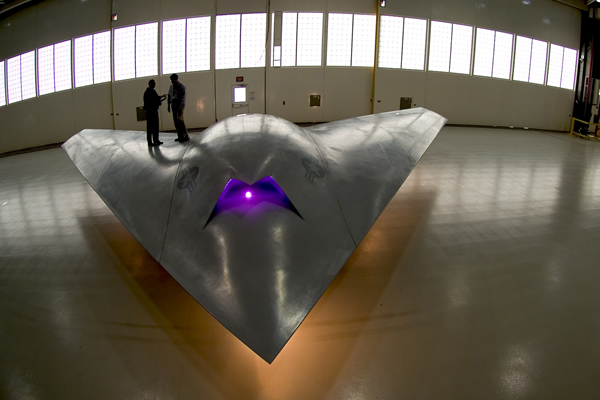http://www.spacedaily.com/reports/US_to_deploy_new_intelligence_drone_in_Afghanistan_report_999.html
US to deploy new intelligence drone in Afghanistan: report
The US military plans to to deploy a new intelligence drone in Afghanistan, which military experts say will allow US troops to monitor much larger operational theaters than before, The Washington Post reported Sunday.
The newspaper said the airborne surveillance system is called Gorgon Stare and will be able to transmit live video images of physical movement across an entire town.
In 2010, a total of 711 international troops were killed in Afghanistan, according to independent website iCasualties -- the highest annual death toll since the war began in 2001.
The system consists of nine video cameras mounted on a remotely piloted aircraft, which can can transmit up to 65 live images to soldiers on the ground or to analysts tracking enemy movements, the paper said.
By contrast, current Air Force drones today shoot video from a single camera over a narrow area the size of a building or two, The Post noted.
"Gorgon Stare will be looking at a whole city, so there will be no way for the adversary to know what we're looking at, and we can see everything," the paper quoted Major General James Poss, the Air Force's assistant deputy chief of staff for intelligence, surveillance and reconnaissance, as saying.
There are around 140,000 international troops fighting the Taliban-led insurgency in Afghanistan, around two-thirds of them from the United States.
earlier related report
US drone strikes kill 15 militants in Pakistan: officials
Miranshah, Pakistan (AFP) Jan 1, 2011 - Three US missile attacks in Pakistan's lawless tribal belt on Saturday killed at least 15 militants and destroyed a Taliban compound, local officials said.
Pakistani officials said the three strikes by unmanned drones in a single day destroyed targets in North Waziristan tribal agency along the Afghan border, a known hub of the al-Qaeda-linked Haqqani network.
They said the first two attacks took place in Mandi Khel, 25 kilometres (15 miles) north of North Waziristan's main town of Miranshah, while the third struck in Datta Khel, some 20 kilometres (13 miles) west of Miranshah.
Seven militants were killed in the first attack when US drones fired four missiles, destroying a car and a militant compound, officials said.
"Three militants were killed in the car while four were killed in the house," a security official in Peshawar told AFP.
In the second attack, a US drone fired two missiles and killed four militants, officials said.
A security official in Peshawar said militants had gathered to rescue the injured and remove the dead from the first attack when they were hit by the second.
The 11 men killed in the first two attacks were thought to be linked to Taliban commander Hafiz Gul Bahadur, security officials in Miranshah and Peshawar told AFP.
One official in Miranshah said they are seeking more information as informants in the area suspect that fighters from overseas were among the dead.
"We have received such reports that four foreigners were also killed in these fresh attacks but their identities are still not known, and we are collecting more information," the official said.
In the latest strike, US drone fired two missiles at a vehicle, killing four militants and taking the day's death toll to 15.
"Two missiles were fired by a US drone and targeted a militant vehicle. We have reports that four militants have been killed," a local security official in Miranshah told AFP.
All three drone strikes and the casualties were confirmed by a senior security official in Peshawar.
US officials say Pakistan-based militants are active in escalating a nine-year insurgency in Afghanistan, putting up a deadly fight against 140,000 US-led NATO troops there and seeking to bring down the Western-backed government in Kabul.
Washington says wiping out the militant threat in Pakistan's semi-autonomous tribal belt is vital to winning the war against the Taliban in Afghanistan and defeating Al-Qaeda.
The Haqqani network, created by Afghan warlord Jalaluddin Haqqani, fights foreign troops in Afghanistan from bases in North Waziristan. The Taliban is also dominant in the restive tribal district, as are Pakistani warlord Hafiz Gul Bahadur and his ally Maulvi Sadiq Noor.
The US does not confirm drone attacks but its military and the CIA operating in Afghanistan are the only forces that deploy the unmanned aircraft in the region.
The covert campaign last year doubled missile attacks in the tribal area, where more than 100 drone strikes killed over 670 people in 2010 compared with 45 strikes that killed 420 in 2009, according to an AFP tally.
Pakistan tacitly cooperates with the bombing campaign, which US officials say has severely weakened Al-Qaeda's leadership.
But it has stalled on launching a ground offensive in North Waziristan, saying its troops are overstretched.
The US strikes are deeply unpopular among the Pakistani public, who see military action on Pakistani soil as a breach of national sovereignty and say some attacks have killed innocent civilians.
Washington says the strikes have killed a number of high-value targets, including the former Pakistani Taliban chief Baitullah Mehsud.





